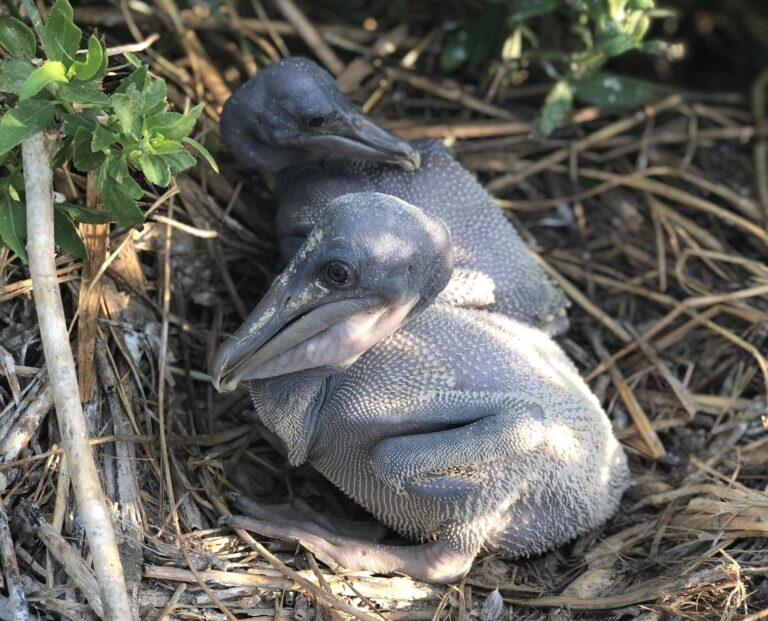Pelican Banding 101: Mind the Beak
For Audubon intern London Thompson, banding Brown Pelicans provides lessons in fortitude and a glimpse into the bird's lifecycle.
I arrived at the pier at 6:30 a.m., armed with rain boots, my trusty hat, and an appetite for adventure. I was confident that my arsenal of supplies would prove to be useful for a long day of banding Brown Pelicans at North Pelican Island.
As the speed boat glided across the Cape Fear River near the North Carolina coast, the butterflies in my stomach began to take flight. At that moment, I realized I was way more nervous than I thought.
We arrived at the island and docked the boat along its marshy edges. Lindsay Addison, Audubon’s coastal biologist, explained that “Banding provides both demographic data that helps scientists monitor bird populations and unique opportunities to see colonial nesting birds.”
She noted that most of the pelicans we would band that day would go on to live in the Southeast U.S. But banding in prior years has shown us that some of the birds will go on to live as far away as Cuba. The North Carolina island they call home in the summer is part of a larger network of coastal sanctuaries protected by Audubon, creating safe nesting grounds for thousands of pairs of pelicans, herons, egrets, ibises, gulls, terns, and other bird species.
Standing on the edge of the island, Addison and independent researcher John Weske finished briefing the group on what to expect before hopping into the marsh.
With shaky hands and cellphone in tow, I took my first steps onto the island. I was welcomed with the fishy smell of pelican poop and water up to my knees. What was I getting myself into?
All of a sudden, a pod of pelicans began to disperse in the air. They’d noticed intruders walking toward their home and fled the scene, leaving their nestlings squawking behind.
Unlike their feathered parents, pelican nestlings looked like baby dinosaurs or aliens from another planet. Some of them were covered in soft white fuzz, while the hatchlings resembled tiny brown uncooked chickens.
Addison explained that birds are banned when they are nestlings. At such a young age, a bird can’t fly. The most they’ll do is scoot or waddle away, making them easier to band.
After we made our way to dry land, Addison walked over to a nestling and demonstrated how it should be handled.
She bent down and grabbed its bill with her left hand. This step was to prevent the animal from snipping at her as she held it. She then picked up the bird with her free hand, making sure to tuck it under her arm to secure one wing to her side. It’s important to hold the bird in a way that prevents it from wiggling out of your hands during the banding process.
Once the nestling calmed down, she grabbed its left foot with the same hand she used to secure the bird to her side. One of the assigned banders walked over with a metal band and placed it around the bird’s right leg. Each band has numbers carved into it that allow biologists to tell where and when the bird was banded.
As the bander used his pliers to squeeze together the ends of the band, Addison stressed how important it is to be careful with these young birds. Above all, our main goal was to quickly band these birds, while respecting their home.
People began following her steps, making sure to quickly and safely band pelicans.
I must have been sticking out like a sore thumb because Addison walked over to me and told me to pick up a bird.
I was apprehensive and unsure of how to avoid being scratched by the bird’s tiny hooked claws. I kept asking her what to do, as if I hadn’t been watching her tutorial on how to band a pelican.
She looked me in the eye and said, “Commit, you have to just commit.”
I gritted my teeth, clenched my fist and went for it.
Within seconds I had a pelican nestling squirming under my arm like all the other volunteers. She coaxed me through holding it to get it to calm down enough to band.
I couldn’t believe I’d banded a bird. It felt good knowing I could be just as useful as everyone else around me.
Banding Brown Pelicans on North Pelican Island was a truly memorable experience that showed me how rewarding it can be to step outside my comfort zone.
Link to article: https://nc.audubon.org/news/pelican-banding-101-mind-beak



